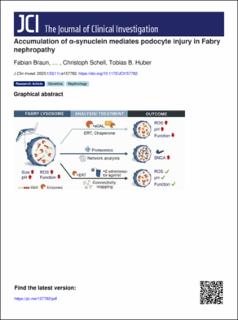| dc.contributor.author | Braun, Fabian | |
| dc.contributor.author | Abed, Ahmed | |
| dc.contributor.author | Sellung, Dominik | |
| dc.contributor.author | Rogg, Manuel | |
| dc.contributor.author | Woidy, Mathias | |
| dc.contributor.author | Eikrem, Øystein Solberg | |
| dc.contributor.author | Wanner, Nicola | |
| dc.contributor.author | Gambardella, Jessica | |
| dc.contributor.author | Laufer, Sandra | |
| dc.contributor.author | Haas, Fabian | |
| dc.contributor.author | Wong, Milagros | |
| dc.contributor.author | Dumoulin, Bernhard | |
| dc.contributor.author | Rischke, Paula | |
| dc.contributor.author | Mühlig, Anne | |
| dc.contributor.author | Sachs, Wiebke | |
| dc.contributor.author | von Cossel, Katharina M | |
| dc.contributor.author | Schulz, Kristina | |
| dc.contributor.author | Muschol, Nicole | |
| dc.contributor.author | Gersting, Sören | |
| dc.contributor.author | Muntau, Ania C. | |
| dc.contributor.author | Kretz, Oliver | |
| dc.contributor.author | Hahn, Oliver | |
| dc.contributor.author | Rinschen, Markus | |
| dc.contributor.author | Mauer, Michael | |
| dc.contributor.author | Bork, Tillmann | |
| dc.contributor.author | Grahammer, Florian | |
| dc.contributor.author | Liang, Wei | |
| dc.contributor.author | Eierhoff, Thorsten | |
| dc.contributor.author | Römer, Winfried | |
| dc.contributor.author | Hansen, Arne | |
| dc.contributor.author | Meyer-Schwesinger, Catherine | |
| dc.contributor.author | Iaccarino, Guido | |
| dc.contributor.author | Tøndel, Camilla | |
| dc.contributor.author | Marti, Hans Peter | |
| dc.contributor.author | Najafian, Behzad | |
| dc.contributor.author | Puelles, Victor G | |
| dc.contributor.author | Schell, Christoph | |
| dc.contributor.author | Huber, Tobias B | |
| dc.date.accessioned | 2023-07-10T06:53:36Z | |
| dc.date.available | 2023-07-10T06:53:36Z | |
| dc.date.created | 2023-04-05T08:29:55Z | |
| dc.date.issued | 2023 | |
| dc.identifier.issn | 0021-9738 | |
| dc.identifier.uri | https://hdl.handle.net/11250/3077406 | |
| dc.description.abstract | Current therapies for Fabry disease are based on reversing intracellular accumulation of globotriaosylceramide (Gb3) by enzyme replacement therapy (ERT) or chaperone-mediated stabilization of the defective enzyme, thereby alleviating lysosomal dysfunction. However, their effect in the reversal of end-organ damage, like kidney injury and chronic kidney disease, remains unclear. In this study, ultrastructural analysis of serial human kidney biopsies showed that long-term use of ERT reduced Gb3 accumulation in podocytes but did not reverse podocyte injury. Then, a CRISPR/Cas9–mediated α-galactosidase knockout podocyte cell line confirmed ERT-mediated reversal of Gb3 accumulation without resolution of lysosomal dysfunction. Transcriptome-based connectivity mapping and SILAC-based quantitative proteomics identified α-synuclein (SNCA) accumulation as a key event mediating podocyte injury. Genetic and pharmacological inhibition of SNCA improved lysosomal structure and function in Fabry podocytes, exceeding the benefits of ERT. Together, this work reconceptualizes Fabry-associated cell injury beyond Gb3 accumulation, and introduces SNCA modulation as a potential intervention, especially for patients with Fabry nephropathy. | en_US |
| dc.language.iso | eng | en_US |
| dc.publisher | American Society for Clinical Investigation | en_US |
| dc.rights | Navngivelse 4.0 Internasjonal | * |
| dc.rights.uri | http://creativecommons.org/licenses/by/4.0/deed.no | * |
| dc.title | Accumulation of α-synuclein mediates podocyte injury in Fabry nephropathy | en_US |
| dc.type | Journal article | en_US |
| dc.type | Peer reviewed | en_US |
| dc.description.version | publishedVersion | en_US |
| dc.rights.holder | Copyright 2023, Braun et al. | en_US |
| dc.source.articlenumber | e157782 | en_US |
| cristin.ispublished | true | |
| cristin.fulltext | original | |
| cristin.qualitycode | 2 | |
| dc.identifier.doi | 10.1172/JCI157782 | |
| dc.identifier.cristin | 2139444 | |
| dc.source.journal | Journal of Clinical Investigation | en_US |
| dc.identifier.citation | Journal of Clinical Investigation. 2023, 133 (11), e157782. | en_US |
| dc.source.volume | 133 | en_US |
| dc.source.issue | 11 | en_US |

